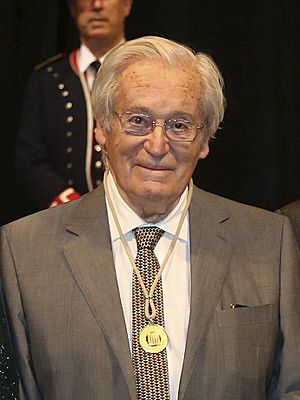Oriol Bohigas facts for kids
Quick facts for kids
Oriol Bohigas
|
|
|---|---|

Bohigas in 2013
|
|
| Born | 20 December 1925 |
| Died | 30 November 2021 (aged 95) Barcelona, Spain
|
Oriol Bohigas i Guardiola (born December 20, 1925 – died November 30, 2021) was an important architect and city planner from Spain. He is famous for helping to make Barcelona a modern city.
Contents
Who Was Oriol Bohigas?
Early Life and Education
Oriol Bohigas was born in Barcelona, Spain, on December 20, 1925. His family was well-off and from Catalonia. His father, Pere Bohigas i Balaguer, was a language expert.
During the Spanish Civil War, Oriol moved to Olot. He finished high school there. In 1951, he became an architect after studying at the Barcelona School of Architecture. He later earned his doctorate in architecture in 1963.
A Vision for Modern Architecture
From a young age, Bohigas wanted to change the way buildings were designed in Barcelona. He believed in modern architecture. In 1950, a group he belonged to was criticized. The government at the time thought modern architecture was too "leftist."
The next year, Bohigas strongly spoke out against the architecture style used during the Francoist period. He then helped start "Grupo R," a group of modern architects.
Building a Modern Barcelona
In the early 1960s, Bohigas started an architecture company called MBM Arquitectes. He worked with David Mackay and Josep Martorell. He also wrote a book about Barcelona's growth.
Bohigas became a professor at the Barcelona School of Architecture in 1964. He was the director of the school from 1977 to 1980. He was part of a group of thinkers who wanted progress for Catalonia.
When Barcelona got its first democratic city council in 1980, Bohigas became the Urban Planning Delegate. This meant he was in charge of city planning. He worked under Mayor Narcís Serra until 1984.
He had a big idea for transforming the city. He wanted to add more facilities and services to neighborhoods. He also wanted the city center to focus on shops and public services.
Oriol Bohigas and the Olympics
One of Bohigas's most important projects was modernizing Barcelona for the 1992 Summer Olympics. He and his team designed "La Vila Olímpica del Poblenou" (the Olympic Village). This area was built on an old industrial site. It helped open the city up to the sea with new gardens, squares, and walkways. He also designed the "Port Olímpic" (Olympic Port).
During this time, he also designed buildings like the Design Museum of Barcelona. For the Seville Expo '92, he designed the "Future Pavilion."
Bohigas's style of architecture changed over time. He moved from an older style called Noucentisme to a more modern style called Rationalism. He was inspired by famous architects like Le Corbusier and Ludwig Mies van der Rohe. Many people consider him the "father" of modern and Olympic Barcelona.
His Impact on Culture
Bohigas was also involved in managing cultural organizations.
- From 1975 to 1999, he led Ediciones 62, a publishing house he helped create.
- He directed the Fundació Joan Miró from 1981 to 1988.
- From 2003 to 2011, he was the president of the Ateneu Barcelonès, a cultural center.
Personal Life
In the 1970s, Oriol Bohigas married architect Beth Galí. She also worked with him in his office. They had five children together. His son Josep also became an architect.
Bohigas believed in progressive politics and a republic. Later in his life, during the Catalan independence movement, he supported the idea of Catalonia becoming independent. He signed a statement supporting the right for Catalans to decide their own future.
Oriol Bohigas had Parkinson's disease starting in 2015. He passed away on November 30, 2021, at his home in Barcelona. He was 95 years old.
Awards and Recognition
Oriol Bohigas received many awards for his work, including:
- Barcelona City Gold Medal of Artistic Merits (1986)
- Medal of Urbanism from the Académie d'architecture (1988)
- Sikkens Award (1989)
- Gold Medal of Architecture from the CSCAE (1990)
- Creu de Sant Jordi (1991)
- The City of Barcelona Award of International Projection (1999)
- Gold Medal from the Col·legi Oficial d'Arquitectes de Catalunya (2007)
- National Award of Architecture (2006)
- National Award of Culture (2011)
- Gold Medal from the Generalitat de Catalunya (2013)
Important Architectural Works
Some of Oriol Bohigas's most well-known projects include:
- Escola Thau Barcelona (1974)
- La Vila Olímpica del Poblenou and the Olympic Port (1992)
- "Pabellón del Futuro" (Future Pavilion) at the Seville Expo '92 (1992)
- Palau Nou de La Rambla, Barcelona (1993)
- Pompeu Fabra University (2001)
- Offices building for the Trade Union UGT in Barcelona (2002–2008)
- Tecnocampus University in Mataró (2004–2011)
- Enlargement of the El Corte Inglés at Plaça de Catalunya (2004)
- Liceu Metropolitan station in Barcelona (2005–2008)
- Auditorium and Sala Gaudí in La Pedrera building from Gaudí in Barcelona (2005–2008)
- Central Police Station in Plaça Espanya, Barcelona (2005–2010)
- White tower in Plaça Europa, Hospitalet del Llobregat (2006–2010)
- La casa dels Xuklis in Barcelona (2006–2011)
- Offices building for RBA Editors in Barcelona (2007–2011)
- Disseny HUB Barcelona (2001–2003)
- Transformation of the area around the Station in Parma, Italy (2001–2015)
See also

- In Spanish: Oriol Bohigas Guardiola para niños

